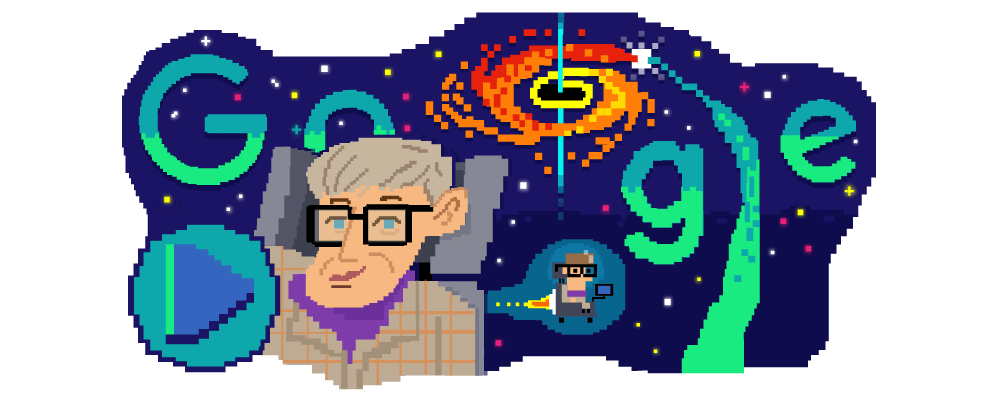Saturday’s Google Doodle Celebrates Physicist Stephen Hawking
Today’s Google Doodle honors the late physicist Stephen Hawking on his
“My goal is simple,” he once said. “It is a complete understanding of the universe, why it is as it is and why it exists at all.”
One of Hawking’s best-known ideas is that black holes slowly regurgitate information about all the matter they’ve swallowed – but it comes out in a jumbled form called Hawking radiation. In 1974, Hawking proposed that the event horizon of a black hole emits energy. Because energy can be converted into mass, and vice versa (that’s what Albert Einstein’s famous equation E=MC2 tells us), emitting all that energy into space will shrink the black hole. Eventually, it will run out of mass and disappear.
The mechanics of why black holes emit energy in the first place are a little complicated if you’re not an expert in quantum physics. But essentially, a black hole’s gravity is so strong that at its event horizon, general relativity (the set of principles that describe how gravity works) and quantum mechanics (the set of principles that describe how subatomic particles behave) overlap in ways that cause weird things to happen to particles.
Under the right conditions, background energy in the universe can convert into pairs of particles: one matter, and one antimatter. Normally, these two particles destroy each other the instant they collide, and the universe settles back into a nice, comfortable equilibrium. But at the event horizon of a black hole, half of the pair may fall into the black hole while the other half escapes. That escaping particle gets emitted back into space as energy, according to Hawking.
Hawking and his colleagues were still debating how Hawking radiation worked in 1997, 23 years after he’d proposed the idea in a paper.
Most objects in space have several properties: mass, radius, chemical composition, and spin (how fast and in what direction the object rotates). But black holes only have two properties: mass and spin. They exist at a single point, called a singularity, so they have no radius. And every bit of matter that falls into a black hole becomes part of the singularity, so it loses its chemical identity, too.
Think of those properties as the metadata for every object in the universe. A principle of physics called the law of conservation of mass says that matter can’t be created or destroyed, only converted into a different form – and physicist John Preskill insisted that must also apply to the information about an object’s properties. He suggested that Hawking radiation should contain information about all the matter that a black hole absorbs. Otherwise, if the information couldn’t escape from the black hole, it would be lost when the black hole eventually evaporated, and that would violate the law of conservation.
Hawking bet Preskill a copy of Total Baseball: The Ultimate Baseball Encylopedia that Preskill was wrong. In 2004, Hawking conceded the bet and presented Preskill with the baseball encyclopedia. According to Hawking’s calculations and models, Hawking radiation did, in fact, contain the metadata for all the matter the black hole had swallowed. But that information must come out completely scrambled.
That meant he should have burned the encylopedia and handed Preskill a box of ashes, Hawking once joked.
The bet with Preskill was entirely characteristic of Hawking, who had a penchant for making similar bets with colleagues – often wagering a book or a magazine subscription – on the outcome of their cosmological research.
Hawking became a household name in the late 1980s because of his skill at explaining physics to people who weren’t physicists. He wrote 8 books, most notably A Brief History of Time (1988), The Universe in a Nutshell (2001), and Brief Answers to the Big Questions (2018). He also co-authored a series of children’s books with his daughter Lucy Hawking, beginning with George’s Secret Key to the Universe (2007).
And he did the majority of that work after being told, in 1963, that he had just two years to live. During Hawking’s last year as an undergraduate student at Oxford University, he began to stumble more often, and his speech started to slur. He received a diagnosis during his first year as a PhD student at Cambridge University: amytrophic lateral sclerosis or ALS. In other words, the motor neurons that carried instructions from Hawking’s brain and spinal cord to his muscles were degenerating. Doctors predicted, at the time, that he had about two years to live.
“My expectations were reduced to zero at 21,” he said. “Everything since then has been a bonus.”
ALS eventually left Hawking paralyzed, and he developed a reputation for steering his wheelchair just as recklessly as he’d steered his rowing crew back at Oxford, where his penchant for risky maneuvers had damaged a few boats.
When paralysis made it impossible for Hawking to speak, he relied on a speech-generation device. He input words and letters into the computer using a handheld joystick at first, but later, he navigated the system by twitching a single cheek muscle. Putting together a sentence this way was a laborious process, but Hawking wrote scientific papers and entire books with the device. His family gave Google permission to recreate his voice for today’s Google Doodle.
It must have been challenging for Hawking to compose responses on the fly, but your faithful correspondent once watched him do it. Hawking had given a presentation at Texas A&M University in late 2009, and afterwards a handful of other physicists took questions from the audience, since – as noted – it would have taken Hawking some time to compose his responses with the speech-generation device. One distinguished physicist was partway through answering an audience member’s question about black holes when Hawking’s distinctive voice cut in with a single word: “No.”
Everyone present conceded the point.






Post a Comment